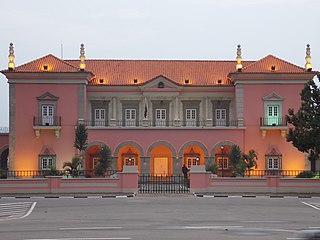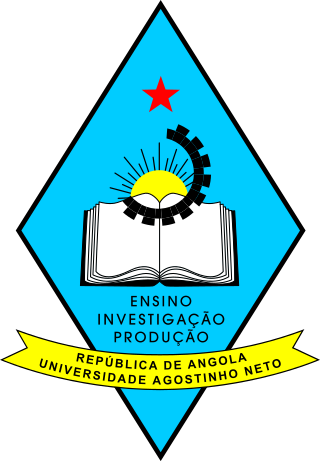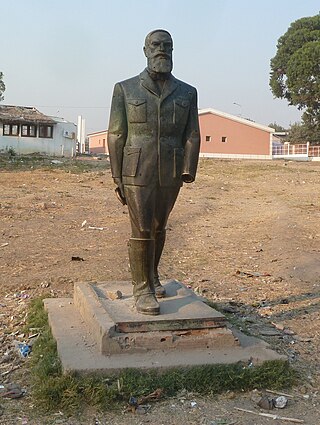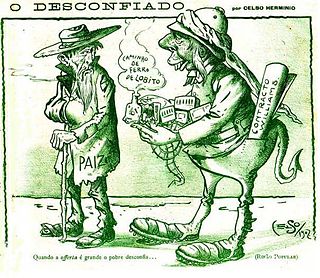This article needs additional citations for verification .(March 2023) |
This is a list of renamed places in Angola .
This article needs additional citations for verification .(March 2023) |
This is a list of renamed places in Angola .
Prior to independence in 1975, Angola was known as Portuguese Angola, or occasionally Portuguese West Africa. Upon independence, the country was renamed the Republic of Angola.
Transport in Angola comprises:

Cuanza Sul Province is a province of Angola. It has an area of 55,660 square kilometres (21,490 sq mi) and a population of 1,881,873. Sumbe is the capital of the province. Dom Francisco Inocêncio de Sousa Coutinho founded the province in 1769 as Novo Redondo.

Huambo, formerly Nova Lisboa, is the third-most populous city in Angola, after the capital city Luanda and Lubango, with a population of 595,304 in the city and a population of 713,134 in the municipality of Huambo. The city is the capital of the province of Huambo and is located about 220 km E from Benguela and 600 km SE from Luanda. Huambo is a main hub on the Caminho de Ferro de Benguela (CFB), which runs from the port of Lobito to the Democratic Republic of the Congo's southernmost province, Katanga. Huambo is served by the Albano Machado Airport.

Uíge is one of the eighteen Provinces of Angola, located in the northwestern part of the country. Its capital city is of the same name.
Porto Amboim is a port town in Cuanza Sul Province, Angola with a population of 65,000; it comprises an area of 4,638 km2. In the past Porto Amboim was connected by an isolated 123 km 610 mm narrow gauge railway to Gabela, albeit closed in 1987 due to the civil war and to the abandonment of most coffee plantations, the biggest source of revenue from Gabela. Originally Porto Amboim was known as Kissonde, a small village later colonized in 1587 by the Portuguese naming it Benguela and later Benguela Velha due to the creation of another village today known as Benguela located 350 km south of Benguela Velha. In 1923, the name was changed to Porto Amboim. Today (2014) Porto Amboim is one of the growing areas for the offshore industry. The pre-salt in front of the coast of Angola, with Porto Amboim in the centre is a planned development area. With companies as Paenal, a joint venture between Sonangol, SBM and DSME and Heerema Porto Amboim, the two major offshore fabrication yards, Porto Amboim is developing.

The Agostinho Neto University is the largest public university of Angola, based in Luanda and in the nearby city of Talatona, in Angola. In the academic year 2005–06, 68 licensing courses were ministered by the university: 18 in Bachelor's and 15 in master's degrees, involving areas of scientific knowledge in the faculties, institutes, and higher learning schools. It is one of seven public universities in Angola. Until 2009 the Agostinho Neto University was the country's only public university, and had campuses in all its major cities. In 2009 it was split up, with its campuses outside Luanda becoming six autonomous universities, located in Benguela, Cabinda, Huambo, Lubango, Malange, and Uíge. Agostinho Neto University is now one of the seven regional university among others, serving Luanda Province and Bengo Province. It remains the largest university in Angola.

António Francisco Ferreira da Silva Porto was a Portuguese trader and explorer in Angola, in the Portuguese West Africa.

Rail transport in Angola consists of three separate Cape gauge lines that do not connect: the northern Luanda Railway, the central Benguela Railway, and the southern Moçâmedes Railway. The lines each connect the Atlantic coast to the interior of the country. A fourth system once linked Gunza and Gabala but is no longer operational.

Railway stations in Angola include:

Angola is located on the western Atlantic Coast of Southern Africa between Namibia and the Republic of the Congo. It also is bordered by the Democratic Republic of the Congo and Zambia to the east. The country consists of a sparsely watered and somewhat sterile coastal plain extending inland for a distance varying from 50 to 160 km. Slightly inland and parallel to the coast is a belt of hills and mountains and behind those a large plateau. The total land size is 1,246,700 km2 (481,400 sq mi). It has an Exclusive Economic Zone of 518,433 km2 (200,168 sq mi).

The Communes of Angola are administrative units in Angola after municipalities. The 163 municipalities of Angola are divided into communes. There are a total of 618 communes of Angola:
Cuilo is a town and municipality in Lunda Norte Province in Angola. The municipality had a population of 21,004 in 2014.

Portuguese Angola refers to Angola during the historic period when it was a territory under Portuguese rule in southwestern Africa. In the same context, it was known until 1951 as Portuguese West Africa.

The history of rail transport in Angola began during the nineteenth century, when Angola was a colony of Portugal. It has involved the construction, operation and destruction of four separate, unconnected, coast-to-inland systems, in two different gauges. Operations on three of those systems have been largely restored; the other system has been closed.

Transporte Colectivo Urbano de Luanda, short TCUL is the public transit company of Angola's capital city, Luanda. TCUL was founded on July 12, 1988. It is a public, i.e. state owned company, depending on the Transport ministry of the central government. Besides 40 bus lines within Luanda province, it also operates over-land bus lines from Luanda to Benguela, Sumbe, N'Dalatando, Malange, Uíge, and Huambo. TCUL disposes of about 300 buses, soon to be extended to 400. The CEO is José Soares de Carvalho de 1988 á 2008 - José Mário Silva de 2008 á 2013 - José António de Freitas Neto de 2013 á 2017 - Abel Cosme de 2017 até a data presente.
The 1980 Girabola was the second season of top-tier football competition in Angola. The season ran from 19 April 1980 to 28 February 1981. Primeiro de Agosto were the defending champions.
The 1982 Girabola was the fourth season of top-tier football competition in Angola. Primeiro de Agosto were the defending champions.